Related Research Articles

Carroll is a town in Coös County, New Hampshire, United States. The population was 820 at the 2020 census. The two largest villages are Twin Mountain and Bretton Woods. Carroll is an important access point for recreational areas in the White Mountains, including many 4,000-footers, the Zealand River area, the Presidential Range, and the Presidential Dry River Wilderness. The town is home to the Mount Washington Hotel at Bretton Woods and to the Highland Center at Crawford Notch, the Appalachian Mountain Club's four-season lodge.

Crawford's Purchase is a township in Coös County, New Hampshire, United States. The purchase lies entirely within the White Mountain National Forest. As of the 2020 census, the purchase had a population of zero.

Erving's Location is a township in Coös County, New Hampshire, United States. As of the 2020 census, the population of the township was zero. In New Hampshire, locations, grants, townships, and purchases are unincorporated portions of a county which are not part of any town and have limited self-government.

Green's Grant is a township in Coös County, New Hampshire, United States. As of the 2020 census, the grant had a population of zero. The grant lies within the White Mountain National Forest. The base of the Mount Washington Auto Road is located in Green's Grant.
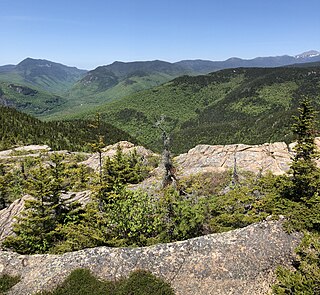
Hadley's Purchase is a township located in the southernmost portion of Coös County, New Hampshire, United States. As of the 2020 census, the purchase had a population of zero. The purchase lies entirely within the White Mountain National Forest.

Jefferson is a town in Coos County, New Hampshire, United States. The population was 1,043 at the 2020 census. It is home to parts of the White Mountain National Forest in the south and northeast and to Santa's Village, a Christmas-themed amusement park. There are also several private campgrounds, motels and inns.

Low and Burbank's Grant is a township in Coös County, New Hampshire, United States. The grant lies entirely within the White Mountain National Forest. As of the 2020 census, the grant had a population of zero.

Joseph Emerson Worcester was an American lexicographer who was the chief competitor to Noah Webster of Webster's Dictionary in the mid-nineteenth-century. Their rivalry became known as the "dictionary wars". Worcester's dictionaries focused on traditional pronunciation and spelling, unlike Noah Webster's attempts to Americanize words. Worcester was respected by American writers and his dictionary maintained a strong hold on the American marketplace until a later, posthumous version of Webster's book appeared in 1864. After Worcester's death in 1865, their war ended.

Eleazar Wheelock was an American Congregational minister, orator, and educator in present-day Columbia, Connecticut, for 35 years before founding Dartmouth College in New Hampshire. He had tutored Samson Occom, a Mohegan who became a Presbyterian minister and the second Native American to publish writings in English. Before founding Dartmouth, Wheelock founded and ran the Moor's Charity School in Connecticut to educate Native Americans. The college was primarily for the sons of American colonists.

Crawford Notch is a major pass through the White Mountains of New Hampshire, located in Hart's Location. Roughly half of that town is contained in Crawford Notch State Park. The high point of the notch, at approximately 1,900 feet (580 m) above sea level, is at the southern end of the town of Carroll, near the Crawford Depot train station and Saco Lake, the source of the Saco River, which flows southward through the steep-sided notch. North of the high point of the notch, Crawford Brook flows more gently northwest to the Ammonoosuc River, a tributary of the Connecticut River.
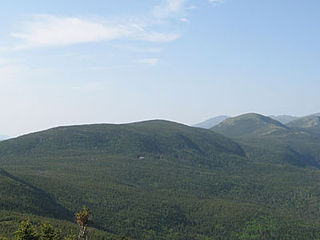
Mount Pierce is a mountain in the Presidential Range in the White Mountains of New Hampshire that is approximately 4,310 feet (1,310 m) high. Formerly called Mount Clinton for 19th-century governor DeWitt Clinton of New York, in 1913 it was renamed after President Franklin Pierce (1804–1869), the only president born in New Hampshire, although it was several decades before the name was widely recognized. Its summit offers a wide view of New Hampshire's mountains.

Boott Spur is a minor peak located in Coos County, New Hampshire, United States. The mountain is named after Francis Boott (1792–1863), and is part of the Presidential Range of the White Mountains. Boott Spur stands on the shoulder of Mount Washington, above the south side of the headwall of Tuckerman Ravine.

Mount Tom is a mountain located in Grafton County, New Hampshire, about 1.5 miles (2.4 km) southwest of the height of land of Crawford Notch.
John Wingate Weeks was a U.S. Representative from New Hampshire, great uncle of John Wingate Weeks.

The Mountain Division is a railroad line that was once owned and operated by the Maine Central Railroad (MEC). It stretches from Portland, Maine on the Atlantic Ocean, through the Western Maine Mountains and White Mountains of New Hampshire, ending at St. Johnsbury, Vermont in the Northeast Kingdom. The line was abandoned in 1983 by MEC's successor, Guilford Transportation Industries (GTI). Guilford retained a stub between Portland and Westbrook. A section in New Hampshire remains in use by heritage railway Conway Scenic Railroad.
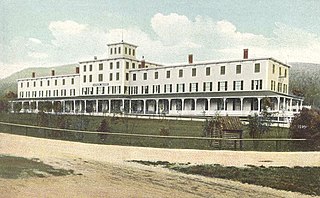
Fabyan House was a grand hotel in the White Mountains of New Hampshire, constructed by Sylvester Marsh who also built the Mount Washington Cog Railway. The hotel burned during construction in 1868 and was rebuilt in 1873. It was destroyed by fire in 1951.
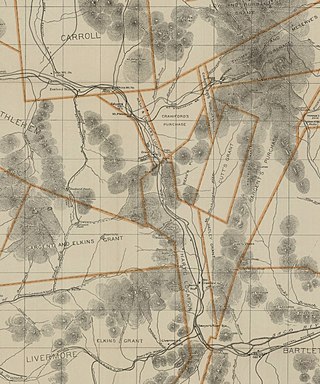
The Crawford family of the White Mountains were a family who moved to New Hampshire's White Mountains in the 1790s from Guildhall, Vermont, and were pioneers in establishing a tourist industry in that area. Abel Crawford and his father-in-law, Eleazar Rosebrook, began the effort, and one of Abel's sons, Ethan Allen Crawford, made significant contributions. Another son, Thomas Jefferson Crawford, continued the work; and Ethan's wife, Lucy, also contributed. Their work was in the area then known as White Mountain Notch, subsequently called Crawford Notch.
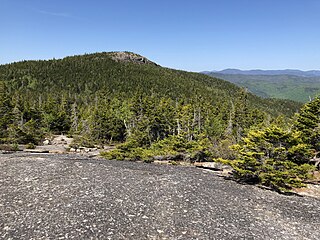
Mount Crawford is a mountain located in Coos County, New Hampshire, in the United States. The mountain is on a spur of Montalban Ridge within the White Mountains and overlooks Crawford Notch. It is accessible via the Davis Path, which climbs from Crawford Notch near the Notchland Inn. The Davis Path continues north up Montalban Ridge to Mount Washington.

The Willey House at Crawford Notch in the White Mountains of New Hampshire is associated principally with a tragedy of August 28, 1826, in which seven members of the Willey family and two other people died. Out of that event came a boost to the nascent tourism industry of the area.

The Crawford Path is an 8.5-mile-long (13.7 km) hiking trail in the White Mountains of New Hampshire that is considered to be the United States' oldest continuously maintained hiking trail. It travels from Crawford Notch to the summit of Mount Washington (Agiocochook). The first iteration of the Crawford Path was cut in 1819 by Ethan Allen Crawford and his father, Abel Crawford. The trail ascends a cumulative 4,900 feet (1,500 m), first through densely wooded forest for about 3.1 miles (5.0 km), then following the exposed southern ridge of the Presidential Range mostly above the treeline.
References
Citations
- ↑ Johnson (2006), pp. 49–62
- ↑ Julyan & Julyan (1993), pp. 34–36
- ↑ Bennett (2003), p. 55
- ↑ Cenkl (2009), p. 44
- ↑ Cenkl (2009), p. 37
- ↑ Cenkl (2009), p. 51
- ↑ Johnson (2006), pp. 62–63
Bibliography
- Bennett, Randall H. (2003), The White Mountains: Alps of New England, Arcadia Publishing, ISBN 978-0-73852-433-7
- Cenkl, Pavel (2009), This Vast Book of Nature: Writing the Landscape of New Hampshire's White Mountains, 1784-1911, University of Iowa Press, ISBN 978-1-58729-714-4
- Johnson, Christopher (2006), This Grand & Magnificent Place: The Wilderness Heritage of the White Mountains, UPNE, ISBN 978-1-58465-461-2
- Julyan, Robert Hixson; Julyan, Mary (1993), Place Names of the White Mountains (Revised ed.), Hanover, NH: University Press of New England, ISBN 978-0-87451-638-8